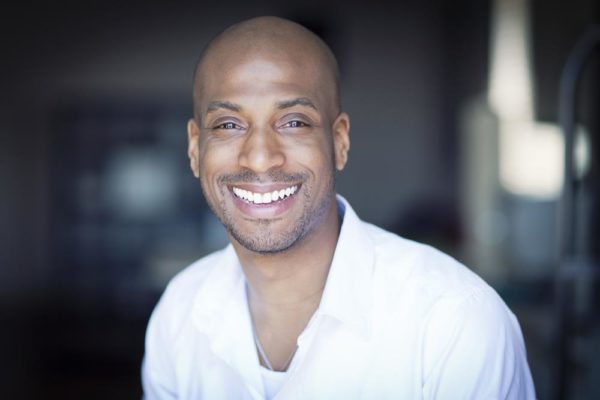Features
Lola Jay: “That His Head Like Fresh Kolanut” – Men, Let’s Talk About Balding!
 The beard gang is in, and many of us ladies absolutely love this look on a man, especially when he sports his bald head together with that full grown beard. However, despite how much we may swoon for this look, the truth is a lot of men feel insecure about losing their hair. To many of them it is their crowning glory (not just for us women).
The beard gang is in, and many of us ladies absolutely love this look on a man, especially when he sports his bald head together with that full grown beard. However, despite how much we may swoon for this look, the truth is a lot of men feel insecure about losing their hair. To many of them it is their crowning glory (not just for us women).
I came to this realisation after having conversations with some acquaintances who were – more often than not, seeking for ways to reverse this process – especially when one is under 30; some say, “that kind of stuff is not supposed to happen so soon.” The unfortunate truth is that 3 in 10 men will start experiencing signs of balding by age 30.
Causes
For the most part, it is hereditary – passed on from one generation to the next. That being said, there could be other causes such as medication, infections, inflammation, malnutrition or severe stress to name a few. It is caused when the genetic makeup of a person makes them more sensitive to the breakdown product of Testosterone called Dihydrotestosterone or DHT for short.
DHT as a hormone is important for the development of the male external genitalia in the womb. It is also important in the development of many male characteristics you see in puberty – such as deepening of the voice and development of chest hairs to name a few. The downside of this hormone, however, is that it can cause hair loss on the scalp.
Baldness Patterns
Male pattern baldness usually occurs in two forms. In the first you get thinning of hair at the temples. In the second form, the thinning occurs from the top of the head or the crown.
How early you lose your hair is very dependent on how early your dad started losing his, hence why we shouldn’t compare with others as the family ‘pattern’ can vary. The good news is the whole process can be slowed down or stopped if caught and treated early.
Treatment
I’ll break the treatment strategies into 3 stages to keep it simple. These include: Lifestyle, Medication and Surgery.
1. Lifestyle
So what lifestyle changes can one implement to encourage hair growth?
- Exercise – This is very important as it helps to encourage blood flow, which feeds the hair follicles with the nutrients it needs to grow. Naturally our skin, hair and nails are the last places to receive nutrients as our other more important organs take precedence. Thus in someone who is active, the blood is pushed around more to these dark forgotten areas.
- Diet – Maintaining a healthy diet, rich in nutrients such as iron is helpful to maintaining a good head of hair. A good diet could also be supplemented with Vitamins containing biotin, which is known to promote hair growth/ health.
- Shampoos/ Conditioners – Although not technically a ‘lifestyle measure’, I personally think that the choice of shampoo or conditioner is important. Sulphate free shampoos are less drying to the hair than normal shampoo causing less breakage.
Furthermore, some people may choose to co-wash instead, (i.e. washing your hair with a conditioner instead of a shampoo). This helps to aid moisture retention and prevent the hair drying out and breaking.
As there are a plethora of shampoos and conditioners out there, I would generally recommend those containing Tea Tree Oil, Castor Oil or Vitamin B compounds which help to stimulate hair growth.
2. Medication
For male pattern baldness, there are two main medications that are used and approved by most regulatory bodies:
- Minoxidil (aka Rogaine) – This comes in two forms, either a solution or a foam that you rub into the hair. It is thought to work by increasing the size of the hair follicle as well as altering the hair cycle to prolong the active hair growth phase (anagen), whilst shortening the resting or ‘dormant’ phase (telogen).
Initially the hair loss may worsen as all the ‘resting’ hairs are pushed out, but do not lose heart, as with continued use, the new hairs would start to grow.
The main side effect of this drug besides dryness is that once you stop the treatment, the new hairs start to fall out within 3 months, thus, it is advised to use it long term unless you find it’s not working for you, of course.
- Finasteride – Remember DHT we mentioned earlier, the breakdown product of testosterone? Well, an enzyme called 5 alpha reductase is needed to break down Testosterone into DHT. So you can imagine that if you do not have this enzyme, will not be able to produce DHT and thus should not go bald.
With this in mind, a drug which blocks the action of this enzyme, (Finasteride) has been licensed to treat male pattern baldness.
Similar to minoxidil, the treatment also has to be continuous otherwise, the hair falls off. Sadly, it also has side effects such as prostate problems, decreased libido and erectile dysfunction which are typically not welcome by many.
3. Surgery
- Hair Transplants – If all else fails, one may opt for hair transplants which can be very costly depending on the surface area of hair needing transplanting. I would recommend speaking to your physician to refer to a transplant surgeon if necessary. I’m not sure if this is available in Nigeria yet, so if anyone knows please leave a comment.
4. Wigs
For the sake of completeness, I included this although I doubt many guys would want to be caught dead or alive wearing a wig, but hey you never know.
So there you have it, male pattern baldness in a kolanut shell 😉
Photo Credit: Andre Nadeau | Dreamstime.com






















